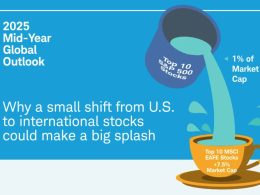by Brian S. Wesbury – Chief Economist & Robert Stein, CFA – Deputy Chief Economist, First Trust Portolios
Conventional wisdom was that the tariffs imposed by the Trump Administration would cause higher inflation and slower growth – stagflation as far as the eye could see. But this past week brought economic news that defied this prediction.
The trade deficit plummeted in April, signaling that economic growth could surge in the second quarter. The Atlanta Fed GDPNow model has Q2 at a +3.8% for now. Inflation also slowed sharply with the Federal Reserve’s preferred measure of inflation now up only 2.1% on a year-ago comparison basis, just a hair above the official target of 2.0%.
Investors can be forgiven for being confused. After real GDP declined at a 0.2% annual rate in the first quarter, many (especially those opposed to Trump) thought this dip was a harbinger of recession, with more declining real GDP ahead.
But, as we said at the time, the decline in Q1 real GDP was largely due to an unprecedented surge in imports (front-running tariffs), and that would reverse in Q2 and beyond. At this point, it looks like this is happening now.
We like to focus on “Core GDP” which is real GDP excluding government purchases, inventories, and international trade, each of which is volatile from quarter to quarter. Core GDP grew at a 2.5% annual rate in Q1, faster than the average annual rate of 2.2% in the past twenty years.
Imagine a store that sells furniture manufactured in both the US and abroad. Once President Trump was elected and seemed intent on eventually raising tariffs, it made sense for that store to “front-run” the tariffs by temporarily increasing orders from foreign suppliers while temporarily reducing orders from US suppliers. Even if sales (consumption) did not change, the accelerated imports were subtracted from GDP, which is what caused the decline in real GDP in Q1.
With Friday’s advance report on international trade in April signaling the largest drop in the trade deficit for any month in modern US economic history, that process is reversing. But even if growth comes in at 3.8%, or better, don’t be confused.
The economy was not in massive trouble in Q1, and it is not booming in Q2. Now that some of the threatened tariffs have finally taken effect, firms selling goods in the US are back to ordering more from their domestic suppliers.
In the meantime, the fact that inflation continues to decline really shouldn’t surprise anyone. The M2 money supply is basically flat since 2022. Yes, tariffs can mean the items being tariffed cost more. But inflation is ultimately a monetary phenomenon, and tariffs don’t change monetary policy. So, if the tariffed goods cost more, that means less money is leftover to buy other goods and services, putting downward pressure on those other items. Net, net, M2 growth says low inflation.
Inflation data show a quiet past three months, with PCE prices up a mere 0.1% in April. They are now up only 2.1% from a year ago, a much slower increase versus last year.
None of this means we are out of the woods on recession risk or that the inflation dragon has been slain. If the Fed were to dramatically loosen monetary policy, inflation could come back quickly. What it does mean is that investors need to be wary of getting caught up in news about the economy that often has a partisan political angle.
Brian S. Wesbury – Chief Economist
Robert Stein, CFA – Deputy Chief Economist
Click here for a PDF version
Copyright © First Trust Portolios















